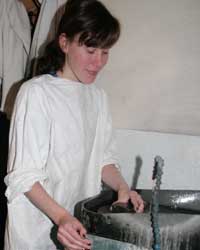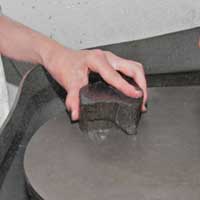Smith
in STRIDE
An occasional Gate series
focusing on the work of STRIDE Scholars.
By
Jennifer DeBerardinis ’11

STRIDE Scholar Katie Castagno ’12 grinds the rock in
a geology lab. |
Katie Castagno ’12
calls it “the rock,” a
shiny black chunk of sediment she displayed recently in her
geology research lab.
Formed around 720 million years
ago, it offers much more than aesthetic appeal. It’s
full of what geologists call “roll-up structures”:
light, thin lines folded on top of each other throughout
the fist-sized sediment sample, an extremely rare geologic
configuration.
It may not seem like much to
the non-geologist, but these unusual folding structures can
provide valuable insight to a time period called Snowball
Earth, when the entire globe is believed to have been entombed
in ice, said Sara Pruss, assistant professor of geology.
The
small rock is so important, in fact, that Pruss and Castagno,
who is working alongside Pruss as a STRIDE (Student Research
in Departments) program scholar, are devoting at least a
year to its study.
STRIDE scholarships are paid
research assistantships with Smith professors in a variety
of disciplines. The two-year scholarships are offered each
year to promising first-year students to provide valuable
experience in academic discovery. In the past two years,
the program has matched 96 students with professors in more
than 30 academic areas.
As a STRIDE Scholar, Castagno’s
job this semester involves constructing a three-dimensional
model of her rare rock “to
get a full picture of the roll-up structures,” she
explained. Pruss collected the sample a couple years ago
from the Republic of Namibia, a country in coastal southwestern
Africa. A post-doctoral fellow in geo-biology at Harvard
University at the time, Pruss had in mind the rock’s
future potential for use in an undergraduate research project.
This
fall, in a fulfillment of Pruss’ planning, Castagno
spends her afternoons grinding down the rock a few millimeters
at a time in 20 separate steps, snapping photos at each stopping
point. Castagno will need the pictures to create a three-dimensional
model of the rock before the end of the semester.
Ultimately,
she and Pruss are trying to figure out how the structures
formed, Castagno said, and that will allow for better understanding
of the time period that produced them.

Close-up of the rock. |
The grinding process,
which takes about 15 minutes each step, can be tedious, Castagno
said as she showed off the spinning rock grinder. And the
procedure involves some trial and error. Since the rock has
to be flat, she’s had to carefully
trim off the edges a few times.
But the payoff is enormous,
she added. Not only is she learning about how the earth looked
millions of years ago. She is also gaining hands-on experience
in the lab. “You
can see the results,” she said.
Next semester, the
project will move to chemical analyses of the rock, said
Pruss, more specifically dissolving the sediment and looking
for organic material.
Pruss believes that microbial
mats—large
communities of tiny single-celled organisms—were responsible
for forming the “roll-up” structures. Seven hundred
and twenty million years ago the microbes and sediment existed
as a doughy substance, resembling something like Play-doh,
she said.
Since fold-up structures are
rare—formed
just before and after the Snowball Earth period—they
provide valuable information about “how the climate
was changing and how sediments were being formed,” Pruss
said.
Though she doesn’t yet
know what exactly caused the roll-up formation—perhaps
earthquakes that made microbial mats shake or sloped sediment
deposition—she
hopes to find the answer as part of Castagno’s project.
Discovering more about the roll-up
structures also allows for a better understanding of the
remarkable time period when they were formed, during which
the global climate transitioned from one like present-day
Greenland more to that of the Bahamas within a few thousand
years, Pruss said.
Despite the rock’s ancient
formation, the roll-up structure project is vital to current
climate studies, said Pruss. “We
are in this midst of climate change, and this gives us a
better perspective on what’s going on right now.” Information
from past climactic changes can be used to determine how
the oceans may respond to current global climate change,
she said.
Her research, said Castagno,
will “definitely
help figure out what exactly is going on.”
Castagno, a self-described “non-science person,” said
her STRIDE research has turned her on to a field she originally
hadn’t considered. Also enrolled in the department’s
Geology in the Field course, she’s realized just how
much she enjoys the study of sediments.
Castagno will continue
grinding the rock until she
has enough images to send off for three-dimensional model
construction. The project could go on for a while, Pruss
said. “These formed once in geologic history . . .there’s
so much to understand.”
|























